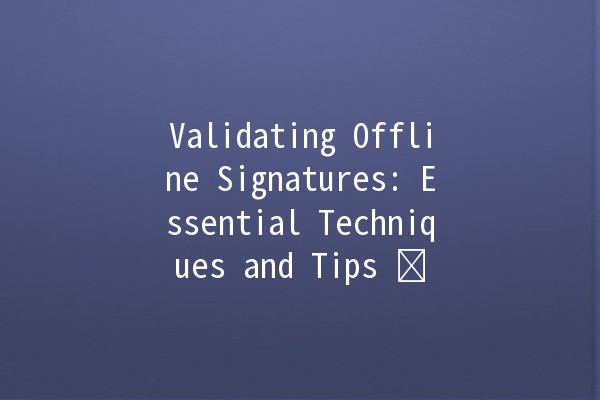
to Offline Signatures
In today's digital age, the concept of offline signatures may seem somewhat outdated, but it remains crucial in various legal and professional scenarios. Offline signatures refer to handwritten marks or signatures made on physical documents rather than provided electronically. As businesses and individuals increasingly embrace digital transformation, understanding how to effectively validate these offline signatures remains vital.
This article will delve deep into the world of offline signature validation, highlighting essential techniques and tips to ensure the authenticity and accuracy of signatures. We will explore various productivityenhancing strategies and provide practical examples to assist you in streamlining your signature validation processes.
Significance of Validating Offline Signatures
Validating offline signatures is a critical process for multiple reasons:

Key Techniques for Validating Offline Signatures 🛠️
Here are five effective techniques to improve the validation process of offline signatures:
Explanation
Comparative analysis involves examining the signature on a document against known samples of the signature of the individual.
Practical Example
If you have a contract signed by a client, compare the signature on the contract with previous documents signed by that client. Look for discrepancies in the shape, slant, and spacing of letters.
Explanation
Different types of ink and paper can provide clues about the authenticity of a signature. For example, ballpoint pens leave specific types of marks that can differ from fountain pen ink.
Practical Example
In a legal case involving a forged document, forensic experts often analyze the ink type and the paper used. They might discover that the ink used in a supposedly old document was only produced recently, indicating forgery.
Explanation
With advancements in technology, various software solutions are available to assist in the validation of signatures. These tools often employ machine learning and artificial intelligence to analyze signature patterns within seconds.
Practical Example
If you regularly handle high volumes of contracts, consider incorporating signature verification software. This will help streamline the verification process without compromising on accuracy.
Explanation
In complex cases where signatures are disputed, it may be wise to consult forensic document examiners or handwriting experts.
Practical Example
Should a signature be contested in court, hiring a forensic handwriting expert can provide an expert opinion on the legitimacy of the signature based on various parameters like stroke length and pressure.
Explanation
Creating a database of verified signatures allows for quicker comparisons in the future. This database can serve as a valuable resource when validating new documents.
Practical Example
For companies dealing with numerous client agreements, maintaining a database of verified signatures can expedite the validation process. New documents can be swiftly checked against stored signatures for inconsistencies.
Common Questions on Offline Signature Validation ❓
Verifying an offline signature is essential for ensuring legal validity and preventing fraud. It helps maintain business integrity and assures parties involved that agreements are legitimate.
While signature verification technology significantly enhances the efficiency of signature validation, it is not foolproof. Incorporating both technology and manual verification leads to the most reliable outcomes.
Ensuring the authenticity of a signature can protect an organization from legal disputes. If a firm fails to properly validate signatures, it may face liabilities, including breach of contract claims.
Common mistakes include not checking the overall document for signs of tampering, relying solely on technology without human oversight, and overlooking minor discrepancies that could indicate forgery.
Improving signature verification skills involves continual education, understanding forensic techniques, and practicing with various signature samples regularly to hone your comparative analysis abilities.
There are numerous online courses, webinars, and workshops focusing on handwriting analysis and signature verification techniques. Additionally, professional organizations often provide resources for ongoing education in this field.
al Thoughts
Understanding how to validate offline signatures effectively is a critical component of modern business practices. With the right techniques, tools, and a focus on due diligence, organizations can protect themselves from the risks associated with forged or invalid signatures. Emphasizing training and ongoing education ensures that employees are wellequipped to handle signature validation accurately and efficiently.
By integrating these methods into your signature validation processes, you can enhance overall productivity while safeguarding your business assets. The tips and techniques outlined here provide a comprehensive toolkit for professionals seeking to master the complexities of offline signature validation.

